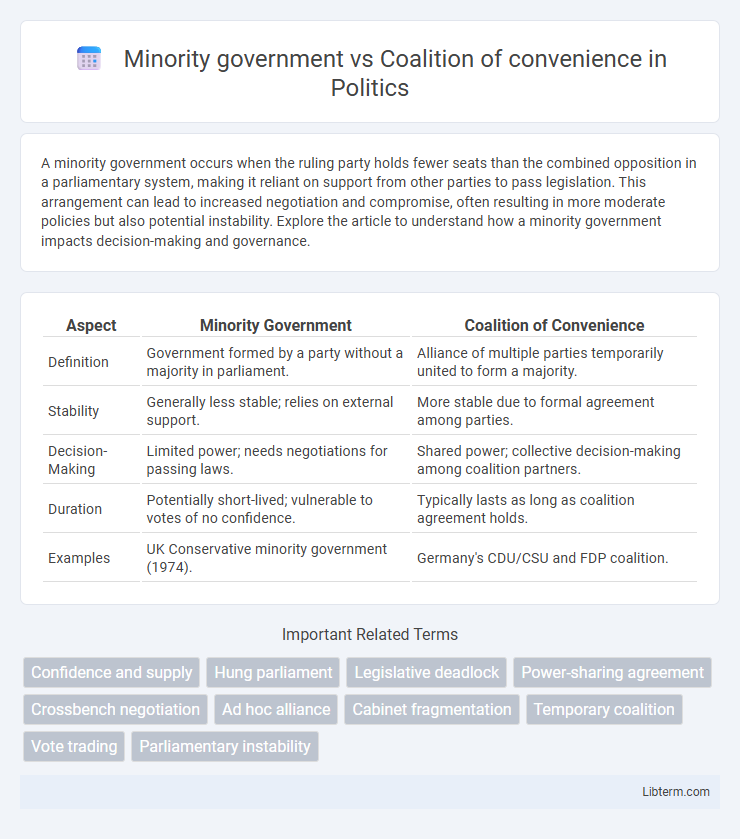A minority government occurs when the ruling party holds fewer seats than the combined opposition in a parliamentary system, making it reliant on support from other parties to pass legislation. This arrangement can lead to increased negotiation and compromise, often resulting in more moderate policies but also potential instability. Explore the article to understand how a minority government impacts decision-making and governance.
Table of Comparison
| Aspect | Minority Government | Coalition of Convenience |
|---|---|---|
| Definition | Government formed by a party without a majority in parliament. | Alliance of multiple parties temporarily united to form a majority. |
| Stability | Generally less stable; relies on external support. | More stable due to formal agreement among parties. |
| Decision-Making | Limited power; needs negotiations for passing laws. | Shared power; collective decision-making among coalition partners. |
| Duration | Potentially short-lived; vulnerable to votes of no confidence. | Typically lasts as long as coalition agreement holds. |
| Examples | UK Conservative minority government (1974). | Germany's CDU/CSU and FDP coalition. |
Introduction to Minority Governments and Coalitions of Convenience
Minority governments occur when a political party holds fewer than half the seats in a legislature, requiring support from other parties to pass legislation. Coalitions of convenience are temporary alliances formed between parties with differing ideologies to achieve a common goal, often to establish or maintain a majority. Both structures influence legislative stability and policy-making dynamics in parliamentary systems.
Defining Minority Government: Key Characteristics
A minority government occurs when the ruling party holds fewer than half the seats in the legislature, relying on external support to pass legislation without forming a formal alliance. Key characteristics include limited legislative power, the need for negotiation with opposition parties, and potential political instability due to fluctuating support. Unlike a coalition of convenience, a minority government operates without a prearranged agreement, making confidence and supply deals crucial for survival.
What is a Coalition of Convenience?
A Coalition of Convenience is a temporary alliance formed between political parties to achieve a common goal or maintain government stability despite significant ideological differences. Unlike a Minority Government, which governs without a majority and relies on issue-by-issue support, a Coalition of Convenience involves formal agreements to share power and decision-making responsibilities. This arrangement often prioritizes pragmatic collaboration over long-term policy alignment.
Historical Examples: Minority Governments in Practice
Minority governments, such as the United Kingdom's Labour government from 1974 to 1979, rely on informal support without formal coalition agreements, often resulting in unstable legislative environments. These administrations contrast with coalitions of convenience, exemplified by Germany's grand coalition governments where parties unite despite differing ideologies to form a stable majority. Historical case studies reveal that minority governments typically face challenges in passing legislation, while coalitions of convenience prioritize stability through negotiated power-sharing arrangements.
Notable Cases: Coalitions of Convenience Around the World
Coalitions of convenience have been notable in countries like Italy, where shifting alliances between the Five Star Movement and the Democratic Party enabled governance despite ideological differences. In Israel, diverse parties frequently form convenience coalitions to secure parliamentary majorities amid fragmented electoral outcomes. These cases illustrate how coalitions of convenience enable minority governments to function by temporarily aligning disparate political factions for stability.
Formation Processes: How Minority Governments and Coalitions Arise
Minority governments arise when a political party wins the most seats but lacks an outright majority, often relying on ad hoc support from other parties to pass legislation. Coalitions of convenience form when multiple parties negotiate formal agreements to share power, combining their seats to establish a stable majority government. The formation process of minority governments depends on post-election negotiation dynamics, while coalitions involve strategic compromises and policy alignments before government formation.
Strengths and Weaknesses: Comparative Analysis
A minority government often benefits from greater policy flexibility and quicker decision-making but struggles with stability and legislative support, risking frequent votes of no confidence. In contrast, a coalition of convenience enhances parliamentary majority and broader resource access, yet faces internal conflicts and policy compromises due to differing party agendas. Both structures demonstrate trade-offs between governance efficiency and political cohesion, impacting overall government effectiveness.
Policy Stability and Legislative Effectiveness
Minority governments often face challenges in policy stability due to their reliance on ad hoc support from opposition parties, resulting in frequent negotiations and potential legislative gridlock. Coalitions of convenience, though formed with minimal ideological alignment, tend to provide greater policy stability through formal agreements and shared executive control, enhancing legislative effectiveness. The structured collaboration in coalitions typically leads to more consistent policy implementation compared to the fluid and uncertain support dynamics in minority governments.
Electoral Outcomes and Voter Perceptions
Minority governments often arise when no single party secures a clear majority, resulting in unstable governance and frequent elections, which can decrease voter confidence and increase electoral volatility. Coalitions of convenience, formed primarily to achieve a majority, may face skepticism from voters due to perceived opportunism, potentially diminishing trust and altering subsequent electoral outcomes. Voter perceptions favor stable governance, so coalitions perceived as ideologically coherent tend to perform better electorally than ad hoc alliances or minority governments struggling to pass legislation.
Future Trends: The Evolving Role of Minorities and Coalitions in Governance
Future trends indicate a shift towards more fluid governance models, where minority governments increasingly rely on informal coalitions or issue-based alliances to maintain stability and pass legislation. The evolving political landscape favors strategic partnerships and flexible coalitions of convenience, allowing diverse parties to influence policy without formal mergers. This adaptability enhances governance efficiency and reflects growing voter demands for inclusive and pragmatic political solutions in complex multiparty systems.
Minority government Infographic

 libterm.com
libterm.com